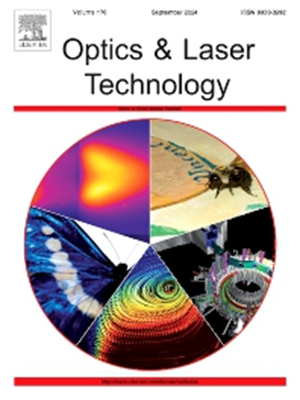Directional emission random lasers based on conical structure for micro-imaging
IF 4.6
2区 物理与天体物理
Q1 OPTICS
引用次数: 0
Abstract
Advancements in directional emission and partial coherence of light sources offer significant potential applications in optical communication, light detection and ranging, and optical imaging. Our study introduces a conical structure, that renders random laser emission directional, with energy primarily concentrated between −5 degrees and 5 degrees. Furthermore, the strong scattering and local surface plasmon resonance of gold nanoparticles enhance the random laser’s performance, resulting in a low threshold and high brightness. The low spatial coherence of the random laser effectively inhibits speckle formation, while its directional emission improves imaging clarity. These two complementary advantages result in the contrast-to-noise ratio of image as high as 16.74. Finally, we demonstrate the proposed random laser’s advantages in biological imaging by imaging a mouse tail section specimen. This research presents a novel light source scheme for applications in optical communication, optical imaging and damage detection.
求助全文
约1分钟内获得全文
求助全文
来源期刊
CiteScore
8.50
自引率
10.00%
发文量
1060
审稿时长
3.4 months
期刊介绍:
Optics & Laser Technology aims to provide a vehicle for the publication of a broad range of high quality research and review papers in those fields of scientific and engineering research appertaining to the development and application of the technology of optics and lasers. Papers describing original work in these areas are submitted to rigorous refereeing prior to acceptance for publication.
The scope of Optics & Laser Technology encompasses, but is not restricted to, the following areas:
•development in all types of lasers
•developments in optoelectronic devices and photonics
•developments in new photonics and optical concepts
•developments in conventional optics, optical instruments and components
•techniques of optical metrology, including interferometry and optical fibre sensors
•LIDAR and other non-contact optical measurement techniques, including optical methods in heat and fluid flow
•applications of lasers to materials processing, optical NDT display (including holography) and optical communication
•research and development in the field of laser safety including studies of hazards resulting from the applications of lasers (laser safety, hazards of laser fume)
•developments in optical computing and optical information processing
•developments in new optical materials
•developments in new optical characterization methods and techniques
•developments in quantum optics
•developments in light assisted micro and nanofabrication methods and techniques
•developments in nanophotonics and biophotonics
•developments in imaging processing and systems

 求助内容:
求助内容: 应助结果提醒方式:
应助结果提醒方式:


